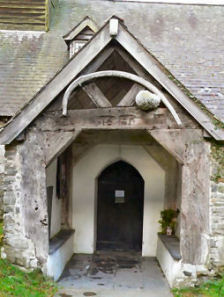Big Bones in Churches November 19, 2011
Author: Beach Combing | in : Medieval, Modern , trackbackAt the end of the nineteenth century the Reverend Wilkins Rees put together a short collection of examples of enormous bones that had found their way into English and Welsh churches. He mentioned five impressive instances, four of which he seems to have seen himself.
1) Foljambe Chapel, Chesterfield Church: ‘This bone, supposed to be the jawbone of a small whale, is seven feet four inches in length, and about thirteen inches, on an average, in circumference.’ ‘It is suspended over an alter tomb. A generally-accepted explanation about this bone – not even disbelieved entirely at the present day – was that it formed a rib of the celebrated Dun Cow [monstrous bovine] of Dunsmore Heath, killed by the doughty Guy of Warwick, with whom local tradition identified the warrior whose marble effigy lies beneath the bone, sent to Chesterfield to celebrate the much-appreciated victory’. Note though that there is a contradictory account in Cox: ‘Another legend respecting the jaw bone of a small whale in the Foljambe chapel, instead of ascribing it to the Warwickshire Dun Cow, assigns it to a local cow of gigantic size, that supplied milk to all the good folk of Chesterfield, no matter how often they went or however large the pails. But an old witch, living by the Common side where the animal grazed, jealous of its fame, went one night with a sieve and milked away till daylight. The excellent animal was so vexed by its inability to fill the vessel, that it went mad, and had to be put to death by a company of archers. In grateful remembrance of its virtues, the inhabitants of Chesterfield placed one of its rib bones within the church.’
2) Chapel of Guy of Warwick (at Guy’s Cliff?): A sixteenth-century account records how ‘in the chapel of the great Guy, Earl of Warwick, which is situated rather more than a mile from the town of Warwick (Guy’s Cliff), there is hung up a rib of the same animal [the fearful Dun Cow], as I suppose, the girth of which in the smallest part is nine inches, the length six feet and a half’.
3) St. Mary Redcliff, Bristol: This church has a ‘ bone said to have belonged to a monster cow which once supplied the whole city with milk. Bristolians, proud of their connection with the great discoverer, Cabot, assert that it is a whalebone brought to the city by the illustrious voyager on his return from Newfoundland. But here the story of Guy of Warwick and the cow has also been introduced.’ It seems that there was also a picture which contains ‘a big figure of a man on the right hand side, while in the foreground lies a prostrate man, behind whom stands a cow. To the left of the picture are certain human figures in attitudes expressive of surprise. This ancient painting was said to refer to Guy’s exploit, and the rib was pointed out as a positive proof that the daring deed was done’.
4) Pennant Melangell: includes a large bone, more than four feet long, which has been described as the bone of the patron saint, Melangell (Asen Melangell). Scholars in the nineteenth century had identified it either as a whale bone and or something belonging to a mammoth: the modern consensus seems to be for the former. It was said to be found on a nearby mountain – the date is unclear – and it was known in the middle of the nineteenth century as the Giant’s Bone (Asen y Gawres).
5) Mallwyd: ‘Over the porch of this church [pictured] some bones are suspended, but no palaeontologist has yet decided as to their origin. It has been said that they are the rib and part of the spine of a whale caught in the Dovey in bygone days!’ There is a modern tradition (with nineteenth-century backing?) that these bones were dug up locally.
We can add to this list:
6) Canewdon (Rochford): what is probably a whale vertebra has been interpreted as the knee of King Canute! (Johnson 199)
Any other giant bones in churches in Britain or elsewhere? Beachcombing is particularly struck by the secular nature of most of these legends: drbeachcombing AT yahoo DOT com
***
21 Nov 2011: Beach is grateful to Lisa who has written in on this: ‘Your post on giant bones at English churches was surprising to me! I thought this was just something at the cathedral in Krakow. Here’s some of the story behind the bones. This site has a great photo. I was too lazy to search through my computer to find the one that I took when I visited. The bones aren’t the only interesting thing about Wawel Hill, where the cathedral is located. This hill has been continuously occupied since the seventh century, and artifacts clear back to the paleolithic have been found there. It is ruin, upon ruin, upon ruin. It is supposed to be one of the Earth’s chakras. Quite a mysterious place.’ Thanks Lisa!
25 Nov 2011: Amanda writes in with some fossils in a church, though not where you would expect… thanks Amanda!



